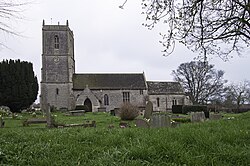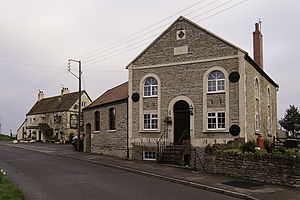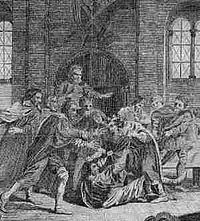Pucklechurch: Difference between revisions
Created page with '{{Infobox town |name=Pucklechurch |county=Somerset |picture=ChurchatPucklechurch.jpg |picture caption=St Thomas a Becket Church, Pucklehurst |os grid ref=ST699764 |latitude=51.48…' |
No edit summary |
||
| Line 1: | Line 1: | ||
{{Infobox town | {{Infobox town | ||
|name=Pucklechurch | |name=Pucklechurch | ||
|county= | |county=Gloucestershire | ||
|picture=ChurchatPucklechurch.jpg | |picture=ChurchatPucklechurch.jpg | ||
|picture caption=St Thomas a Becket Church, Pucklehurst | |picture caption=St Thomas a Becket Church, Pucklehurst | ||
Revision as of 21:45, 4 December 2019
| Pucklechurch | |
| Gloucestershire | |
|---|---|
 St Thomas a Becket Church, Pucklehurst | |
| Location | |
| Grid reference: | ST699764 |
| Location: | 51°29’11"N, 2°26’2"W |
| Data | |
| Postcode: | BS16 |
| Local Government | |
| Council: | South Gloucestershire |
| Parliamentary constituency: |
Thornbury and Yate |
Pucklechurch is a village in Gloucestershire, at the edge of the Cotswolds, east of Bristol.
Pucklechurch is a historic village with an incredibly rich past, from the Bronze Age with its tumulus on Shortwood Hill, up to the siting of a barrage balloon depot in Second World War. Infamy descended on the place in 946 when King Edmund I was stabbed to death in his hunting lodge here by a thief.
Located near the Bristol Ring Road (A4174), the quaint village of Pucklechurch is at the top of an escarpment, with fine views towards the Cotswolds, about four miles east. It is renowned for its village garden competitions, which take place during the summer each year. It is near both the cities of Bristol and Bath (Somerset).
The village

Its population is approximately 3,000 and contains a church, a primary school, shops including a small bakery, a small hairdresser, a local convenience store and a newsagent used by both locals as well as passing trade, and a small post office.
There is a recreational ground in the centre of this historic village, called the "Rec". It is near the village hall. Many events are hosted on the Rec throughout the year, including the "Pucklechurch Revel".
Ashfield Young Offenders Institute is in a secluded location on the outskirts of Pucklechurch,[1] on a small business park.
History

Anglo-Saxon
Behind Pucklechurch's Star Inn is the site of an ancient royal villa, where on 26 May 946, King Edmund I of England was murdered by Liofa the thief, while at meat in his hunting lodge in Pucklechurch:
946 . This year King Edmund died, on St. Augustine's mass day. That was widely known how he ended his days:, that Liofa stabbed him dead at Pucklechurch. And Æthelflæd of Damerham, Ealdorman Ælfgar's daughter, was then his queen and he had reigned six and a half years."[2]
It is said that Liofa was a thief, who entered the King's hall during a feast to steal, but when seized he stabbed the man who held him, who happened to be the King.
In 950 Edmund's successor, King Eadred, gave 25 hides of land at Pucelancyrcan to the Abbey of Glastonbury.[3]
Middle Ages
The Domesday Book records these hides as belonging to St. Mary's church, which was in Glastonbury Abbey's grounds.[4] It notes:[5]
"St Mary of Glastonbury holds Pucklechurch. There are twenty hides. In demesne are six ploughs and twenty three villeins and eight bordars with eighteen ploughs. There are ten slaves and six men render 100 ingots of iron less ten and in Gloucester one burgess pays 5d and two coliberts pay 34d and there are 3 Frenchmen and two mills rendering 100d. There are sixty acres of meadow and woodland half a league long and a half broad. It was worth £20, now £30".
From 1275 the manor of Pucklechurch was held by the Bishop of Bath and Wells, who received it from Glastonbury Abbey.
Denys family
To save his see from the administrative burden of collecting all the rents within the manor, the Bishop farmed the manor to Sir Gilbert Denys (d.1422), of nearby Siston, that is to say they gave him the right to keep all the rents he could collect in exchange for an annual payment of £40. Denys already held the next-door manor of Siston.

At the Dissolution of the Monasteries the manor was granted to William Herbert, 1st Earl of Pembroke from whom it was acquired by Sir Maurice Denys (d.1561), Treasurer of Calais and builder of Siston Court. From him the manor passed to his cousin Hugh Denys, and a cadet branch of the Denys family became lords of the manor of Pucklechurch until the death of William Dennis in 1701, last of the male line. The Heralds' Visitation of Gloucestershire in 1623 records John Denys (d.1559) as "of Pucklechurch", High Sheriff of Gloucestershire in 1551. In St. Thomas Becket Church is a memorial to Henry Dennis (d.1638), Squire of Pucklechurch, son of John "Dennys", fisherman and poet who wrote the earliest English poetical treatise on fishing "The Secrets of Angling" published in 1613.
Coal mining
Parkfield Colliery operated near Pucklechurch from 1851 to 1936. Bristol Archives hold several documents detailing the leases & sale of the coal mining rights by Mary and Elizabeth Dennis, the co-heiresses of William Dennis(d.1701). A deed dated 2 Feb. 1719 reads thus:[6]
"Articles of Agreement - 1) Mary Dennis of Westminster, Middx. singlewoman 2) John Whitewood of Mangotsfield, Glos., coalminer and Daniell Alsopp of Pucklechurch, Glos. yeo. - granting licence to dig for coals upon farm in or near Shortwood in Pucklechurch rented from her by Daniell Alsopp and to carry away and sell the same. Term 120 years. Whitewood and Alsopp to pay her 3s. for every 20s. worth of coal. Covenants re.making good of damage, appointment of clerk to keep accounts, etc."
Twentieth century
During Second World War there was a barrage balloon depot.[7] There was a non-flying Royal Air Force station called RAF Pucklechurch from 1952 to 1962, when the site was transferred to HM Prison Service.
The site was used as a remand centre]] and later became Ashfield Young Offender Institution]]. In 1990, there was a big riot at the prison which made headline national news.
Recreation Ground
Now the centre for open-air recreation for the village. The Recreation Ground was formerly the great central enclosure for the village, called "The Burrell" on the tithe map of 1843, which may mean "a defended site set on a hill". Evidence suggests that Pucklechurch was a place of great importance, even before the tenth century. This was a royal centre, a "burh", with a minster church closely associated with it and eventually came into the hands of Glastonbury Abbey. The Burrell must have retained its royal functions as a meeting place for the hundred the administrative unit in early times and has been an open area for over 1,000 years.
Outside links
| ("Wikimedia Commons" has material about Pucklechurch) |
References
- ↑ HMP & YOI Ashfield
- ↑ Anglo-Saxon Chronicle Peterborough / Worcester Chronicle (946) Her Eadmund cyning forðferde on Sancte Agustinus mæssedæge, þæt wæs wide cuð hu he his dagas geendode, þæt Liofa hine ofstang æt Puclancyrcan. 7 æþelflæd æt Domerhame, ælfgares dohter ealdormannes, wæs þa his cwen, 7 he hæfde rice seofeðe healf gear.
- ↑ Puckleweb
- ↑ Glastonbury Abbey at Brittania History
- ↑ Domesday Book: A Complete Transliteration. London: Penguin, 2003. ISBN 0-14-143994-7 p.454
- ↑ Bristol Archives AC/AS/62/1
- ↑ A short history of No.11 Balloon Centre at Pucklechurch, 1939 to 1945, and RAF Station Pucklechurch, 1945 to 1959
